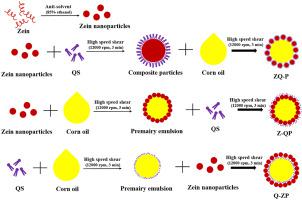Food Hydrocolloids ( IF 11.0 ) Pub Date : 2022-12-04 , DOI: 10.1016/j.foodhyd.2022.108372 Song Cui , Zhenyu Yang , David Julian McClements , Xingfeng Xu , Xin Qiao , Liyang Zhou , Qingjie Sun , Bo Jiao , Qiang Wang , Lei Dai

|
Pickering emulsions are increasingly being explored for their potential applications within the food industry. However, the stability of these emulsions is often limited when stabilized by single colloidal particles. Herein, we examined the possibility of improving the performance of Pickering emulsions by using a combination of colloidal particles (zein nanoparticles, Z) and small molecular emulsifiers (quillaja saponin, Q). The stability mechanism of Pickering emulsions was explored from microscopic to macroscopic scales using QCM-D, microrheology, and Cyro-SEM, et. Corn oil-in-water Pickering emulsions were prepared by adding the Z and Q in different sequences: (i) mix Z and Q and then homogenize (“ZQ-P”); (ii) add Z, homogenize, and then add Q (“Z-QP”); (iii) add Q, homogenize, and then add Z (“Q-ZP”). The sequence significantly influenced the interfacial structure and properties of Pickering emulsions. Macroscopic rheology and microrheology showed that the Pickering emulsions formed an elastic-like structure (G′>G″) and their viscoelastic properties increased over time. QCM-D analysis showed that the properties of the interfacial layers depended on the emulsifier addition sequence used to form the Pickering emulsions. The interfacial membranes formed using the Q-ZP sequence were the thickest (5.8 nm). Cyro-SEM imaging showed that nanoparticle bridges formed between neighboring droplet surfaces, which led to the formation of a 3D network that provided mechanical strength. Overall, this study showed that the Q-ZP addition sequence was the most effective at forming stable Pickering emulsions. It provides new insights that may facilitate the formation of plant-based Pickering emulsions with improved functional performance in food applications.
中文翻译:

不同添加顺序两步乳化法纳米蛋白与小分子乳化剂共稳定Pickering乳液的稳定性机制:从微观到宏观
人们越来越多地探索皮克林乳液在食品工业中的潜在应用。然而,当用单个胶体颗粒稳定时,这些乳液的稳定性常常受到限制。在此,我们研究了通过使用胶体颗粒(玉米醇溶蛋白纳米颗粒,Z)和小分子乳化剂(皂树皂苷,Q)的组合来提高 Pickering 乳液性能的可能性。利用 QCM-D、微观流变学和 Cyro-SEM 等从微观到宏观尺度探索了 Pickering 乳液的稳定性机制。通过按不同顺序添加 Z 和 Q 来制备玉米水包油 Pickering 乳液:(i) 混合 Z 和 Q,然后均化(“ZQ-P”);(ii) 添加 Z,均化,然后添加 Q(“Z-QP”);(iii) 添加 Q,均化,然后添加 Z(“Q-ZP”)。该顺序显着影响了皮克林乳液的界面结构和性能。宏观流变学和微观流变学表明,皮克林乳液形成类弹性结构(G'>G''),并且其粘弹性随着时间的推移而增加。QCM-D 分析表明,界面层的特性取决于用于形成皮克林乳液的乳化剂添加顺序。使用 Q-ZP 序列形成的界面膜最厚 (5.8 nm)。Cyro-SEM 成像显示,相邻液滴表面之间形成了纳米粒子桥,从而形成了提供机械强度的 3D 网络。总的来说,这项研究表明 Q-ZP 添加顺序在形成稳定的皮克林乳液方面最有效。


















































 京公网安备 11010802027423号
京公网安备 11010802027423号